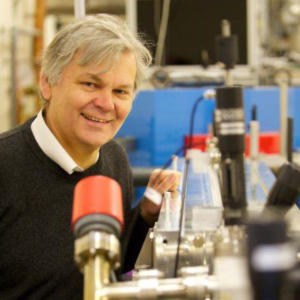Conférencier.ère : Prof. Dino Jaroszynski (Université de Strathclyde, UK)
Date et heure : Mercredi, 2 avril, 10h à 11h (heure de l'Est)
Pour assister au séminaire ou pour avoir accès à son enregistrement, contactez la coordonnatrice du programme (genevieve.boudreau@inrs.ca).
Titre : Plasma photonics for manipulating intense laser beams
Next generation of ultra-high-power, ultra-short-pulse lasers, are now approaching 10s-100s PW to exawatts peak powers. They are huge because of the relatively low damage-threshold optical media used for their beam delivery systems. An alternative and robust medium for manipulating intense laser pulses is plasma, because it is fully ionised. Ultra-compact plasma Bragg gratings can be formed by ballistically evolving ions. They phase-correlated gain momenta from the space-charge fields produced by electron density modulations, which are created by the ponderomotive force of the beat wave of intercepting counter-propagating “pump” laser pulses. Ions evolving into an ion structure and ultra-mobile electrons neutralise the ion fields to form a plasma photonic structure, which can efficiently scatter incident probe pulses incident. This two-step inertial bunching mechanism can be used to create robust diffractive optical media for manipulating intense laser pulses. We show experimentally and theoretically, that intense ultrashort pulses can scatter off plasma photonic structures with high intrinsic efficiency. We present evidence that the plasma photonic structure is birefringent and can act as a lens, a high efficiency mirror and an amplifier.
Bio du Prof. Dino Jaroszynski
Professor Dino Anthony Jaroszynski was born in Helsinki Finland and grew up in South Africa before settling in the UK to complete his studies and commence his academic career. He was awarded BSc Honours and PhD degrees in physics by the University of Manchester. He then worked at Heriot-Watt University and a number of well-known European laboratories on free-electron lasers (FELs) before taking up a permanent position at the University of Strathclyde.

Over this period he established an international reputation and made several significant advances in the field of collective radiation-matter interactions and FELs, a theme that still dominates his current activities. He is passionate about applying new technologies derived from advances in physics and set up the Scottish Centre for the Application of Plasma-based Ac
celerators (SCAPA), which promotes a two-way engagement between scientific ideas arising from research and their commercial output. He sees no contradiction between “blue skies” research and the application of scientific knowledge for the benefit of society. SCAPA is a new user facility comprising several lasers and shielded “bunkers” with beamlines. SCAPA provides state-of-the-art research tools including a 40 TW at 10 Hz, 350 TW at 5 Hz and 0.1 TW at 1 kHz laser beams for the study of high-field, ultra-short pulse radiation-matter interactions. He set up and leads a project, Advanced Laser Plasma High-energy Accelerators towards X-rays (ALPHA-X), to investigate laser-plasma acceleration and applications as a compact light sources. ALPHA-X made several pioneering advances: e.g. controlled particle acceleration using laser-driven plasma waves and a compact synchrotron source based on a laser-plasma accelerator, which could revolutionise the way science is done. He was first to propose using laser-plasma accelerators for ultra-compact FELs. He has broadened his research interests to investigate the creation of regular plasma structures and study their optical properties and their potential as ultra-compact radiation sources.
In addition to his research leadership, Prof. Jaroszynski serves as the Chair of ICUIL (International Committee on Ultra-Intense Lasers), playing a key role in shaping the global scientific agenda for high-intensity laser science. He is actively involved in international scientific collaborations, conferences, and publishing, and has made substantial contributions to the development and application of compact accelerator technologies. He is also interested in the interface between art and science – and promoting the public engagement with science. He set up a project engaging physicists and artists, a poet and a photographer, to reflect the world of the scientists through the eyes and language of artists.
Pour la série complète des séminaires, visitez : ultrafast-coast-to-coast.ca.
Au plaisir de vous y voir!
